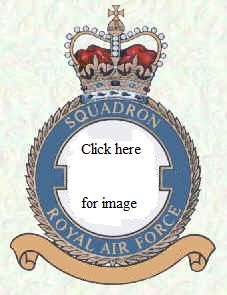Air of Authority - A History of RAF Organisation
No 261 - 265 Squadron Histories
Squadron Codes used: -
| WY | Allocated Apr 1939 - Sep 1939 |
| FJ | Jun 1944 - Sep 1945 |
[Aircraft & Markings | Commanding Officers]
|
No Badge Authorised |
This squadron was never formed or planned to be formed during World War One and came into being for the first time on 29 September 1942 composed of personnel en-route to South Africa. Arriving in Durban in November it set up its HQ at Congella, but it was February 1943 before its equipment in the form of Catalinas arrived. These were used to patrol the Indian Ocean and detachments were also operated from Sierra Leone and Langebaan, extending its patrol area into the South Atlantic and around the Cape of Good Hope. At the end of 1943, the squadron was transferred to the control of SAAF Coastal Area and it began to receive increasing numbers of South African personnel. By the end of 1944, the squadron was totally manned by South African personnel and on 15 February 1945 was disbanded by being renumbered No 35 Squadron SAAF. |
Squadron Codes used: -
| QY | Allocated Apr 1939 - Sep 1939 |
| TR | 1944 |
[Aircraft & Markings | Commanding Officers]
No 263 (Fellowship of the Bellows) Squadron
 Formed
27 September 1918 from No's 359, 435, 436 and 441 Flts at Otranto, flying Short
184/320 and Sopwith Baby seaplanes and Felixstowe F3 flying boats, which it used
to provided anti-submarine patrols over the Adriatic. It disbanded on 16
May 1919.
Formed
27 September 1918 from No's 359, 435, 436 and 441 Flts at Otranto, flying Short
184/320 and Sopwith Baby seaplanes and Felixstowe F3 flying boats, which it used
to provided anti-submarine patrols over the Adriatic. It disbanded on 16
May 1919.
The squadron reformed in the fighter role at Filton on 2 October 1939 equipped with Gladiators. Those were allocated to the British Expeditionary Force, which went to Norway in April 1940, from where the squadron operated from a frozen lake. Many aircraft were lost due to attacks on their base and at the end of the month it returned to the UK. Re-equipped it returned to Norway in May, but the situation was now untenable and the squadron was evacuated aboard HMS Glorious on 6 June but two days later the carrier was sunk, with the loss of all the aircraft and most of the air-crew.
The squadron began to reform at Drem on 12 June 1940 as the first unit to be equipped with the Westland Whirlwind twin engined fighter. Initially Hurricanes were used, with the first Whirlwind arriving in July. Based in Scotland throughout the Battle of Britain, the squadron moved south in November and began convoy patrols and from June 1941, offensive operations over France and the Channel. The squadron's aircraft were converted to the fighter-bomber role in June 1942 with attacks concentrating on coastal shipping and enemy airfields.
Conversion to Typhoons began in December 1943 and as part of 2nd Tactical Air Force, it resumed operations in February 1944. After the invasion the squadron converted to the use of rocket projectiles as its main armament remaining as such until the end of the war. The squadron moved to France in August 1944 and continued to support the advancing armies through France, Belgium, Holland and into Germany, disbanding at Hildesheim on 28 August 1945.
The following day the squadron was reformed by renumbering No 616 Squadron at Acklington. It was now equipped with Meteor jet fighters, which in its various models remained its main equipment until February 1955 when it converted to Hunters. Various moves occurred until the squadron arrived at Wattisham in October 1950, remaining there until August 1957 when it transferred to Stradishall, where it disbanded on 1 July 1958. The squadron reformed once more on 1 June 1959 as a Bloodhound surface-to-air missile at Watton, finally disbanding on 10 June 1959.
Squadron Codes used: -
| SK | Allocated Apr 1939 - Sep 1939 |
| HE | Oct 1939 - May 1950 |
[Aircraft & Markings | Commanding Officers]
No 264 (Madras Presidency) Squadron
Squadron Codes used: -
| WA | Allocated Apr 1939 - Sep 1939 |
| KV | Allocated, but not used |
| PS | Mar 1940 - Aug 1945, May 1947 - Feb 1952 |
| VA | Nov 1945 - May 1947 (Codes taken over from No 125 Sqn) |
[Aircraft & Markings | Squadron Association | Commanding Officers]
No Badge Authorised |
This unit was intended to form in August 1918 from No's 364, 365 and 366 Flights at Gibraltar, flying Felixstowe F2As and Short 184s, however, it formation was cancelled. The squadron reformed at Mombasa from a draft of personnel that had arrived aboard the troopship Lancashire. However, it did not receive any aircraft until April, so its personnel were detached to other units pending their arrival. The first Catalina arrived on 25 April at Diego Suarez in Madagascar, to where the squadron HQ had moved in March. Patrols covered the Indian Ocean for the rest of the war, with the maintenance base being moved to Kipevu in May 1943 and various advanced bases being used for detachments. The squadron disbanded on 30 April 1945.
|
Squadron Codes used: -
| KU | Allocated Apr 1939 - Sep 1939 |
| TR | 1944 |
[Aircraft & Markings | Commanding Officers]
Squadron badge image on this page is courtesy of Steve Clements
© Crown Copyright is reproduced with the permission of the Directorate of Intellectual Property Rights
This page was last updated on 17/03/25©
![]() Organisational Index
Organisational Index ![]()